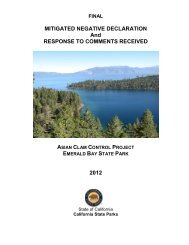Anza Borrego Desert State Park - California State Parks - State of ...
Anza Borrego Desert State Park - California State Parks - State of ...
Anza Borrego Desert State Park - California State Parks - State of ...
You also want an ePaper? Increase the reach of your titles
YUMPU automatically turns print PDFs into web optimized ePapers that Google loves.
Final Report – October 2001<br />
common medium <strong>of</strong> first awareness <strong>of</strong> the <strong>Park</strong>. More than 62% (1081 <strong>of</strong> 1722) <strong>of</strong> the<br />
visitors surveyed reported word <strong>of</strong> mouth as the medium <strong>of</strong> their first exposure to<br />
information about the <strong>Park</strong>. Less significant sources <strong>of</strong> information were guidebooks and<br />
road maps. This characteristic was consistent across both seasons and all sites. Visitors<br />
reported their intention to return to the park at a rate <strong>of</strong> 87% (1619 <strong>of</strong> 1851). This ranged<br />
from a low <strong>of</strong> 79% at the Visitors’ Center to high <strong>of</strong> over 93% at Coyote Canyon, Fish<br />
Creek, and Blair Valley. Over 59% <strong>of</strong> the visitors surveyed reported that their visit<br />
included at least one overnight stay in the <strong>Park</strong>. Nevertheless there was considerable<br />
variability across sites, ranging from a low <strong>of</strong> 34% at the Visitors’ Center (122 <strong>of</strong> 359) to<br />
a high <strong>of</strong> over 80% at Blair Valley (117 <strong>of</strong> 146). This question was asked in the spring<br />
survey only, so no comparison can be made between seasons. A majority (54%) <strong>of</strong> <strong>Park</strong><br />
visitors (410 <strong>of</strong> 754) stayed in primitive or developed campsites within the <strong>Park</strong>. An<br />
additional 20% (157 <strong>of</strong> 754) reported staying in open camping areas within the <strong>Park</strong><br />
during their visit.<br />
When asked about their reasons for visiting the <strong>Park</strong>, respondents consistently ranked a<br />
cluster <strong>of</strong> motivations: scenic beauty, unique characteristics, wildness, nature displays<br />
and sanctuary for wildlife. According to visitors, the <strong>Park</strong>’s role as an economic<br />
resource, a place to be free from society’s rules and regulations, and a place for social<br />
interaction were relatively less important. Measurements <strong>of</strong> the importance <strong>of</strong> the <strong>Park</strong><br />
to visitors also displayed themes, although there was more variability across seasons<br />
and sites than seen in the visitors’ motivations to visit. This variability in the responses<br />
suggests that there is a rather wide range <strong>of</strong> opinions about the role the <strong>Park</strong> should<br />
occupy. Visitors’ assessments <strong>of</strong> how the <strong>Park</strong> is managed were generally positive and<br />
supportive. As a group, visitors expressed an interest that the <strong>Park</strong> be managed as a<br />
refuge, and as a showcase for displays <strong>of</strong> nature. The general trend in the data is that<br />
actions related to the preservation <strong>of</strong> the <strong>Park</strong>’s resources are viewed as more important<br />
than changes in facilities, or development targeting recreational use, visitor concerns or<br />
local interests.<br />
In all sites except the Visitors’ Center, additional questions in the survey included<br />
presenting the visitors with a series <strong>of</strong> photos portraying a range <strong>of</strong> ecological or<br />
management conditions, and asking them to rank each photo according to acceptability.<br />
In general, visitors preferred more natural, less impacted conditions, but were accepting<br />
<strong>of</strong> less than optimum conditions. In Coyote Canyon, the photos depicted a range <strong>of</strong> <strong>of</strong>froad<br />
impacts to vegetation, from pristine conditions to heavily scarred. A majority <strong>of</strong><br />
visitors were accepting <strong>of</strong> a small amount <strong>of</strong> impact, the result <strong>of</strong> minor intrusions <strong>of</strong> <strong>of</strong>froad<br />
vehicles, but at increasing levels visitors judged conditions to be unacceptable.<br />
Surveys at Blair Valley and Fish Creek used the same approach to gauging<br />
acceptability, but the issue in these two locations was crowding. The photo series in this<br />
case portrayed a span <strong>of</strong> conditions ranging from solitude to extremely crowded<br />
conditions. In both sites, visitors displayed some tolerance for a certain amount <strong>of</strong><br />
crowding but exhibited a threshold at which conditions became unacceptable. In general,<br />
the fewer the number <strong>of</strong> other groups in the photo, the higher the rating <strong>of</strong> acceptability.<br />
The <strong>Borrego</strong> Palm Canyon and Mountain Palm Springs surveys included a photo series<br />
depicting a range <strong>of</strong> trail standards from primitive and unmarked to heavily signed and<br />
paved. The results from this set <strong>of</strong> questions were enigmatic; visitors were mostly<br />
accepting <strong>of</strong> all conditions except for the most extreme—the signed and paved trail. In<br />
fact, the rating <strong>of</strong> acceptability increased with the conditions represented by photos<br />
5
















